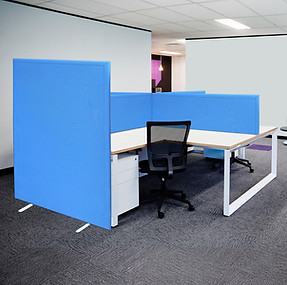01487 710800
MON - FRI 9:00am to 5:00pm
Est. 1968
Made in the UK
The original inventors of the desk divider screen.
Class "A" Acoustic Office Screens
Tested to BS EN ISO 354:2003
Acoustic office screens or acoustic wall boards.
Products with an impeccable pedigree.
ECO's Acoustic office screens, desk dividers and wall boards have for 30 plus years given countless customer the gift of quiet office space, our acoustic products have from the outset been designed to combat noise pollution in the office.
ECO’s Acoustic office screens, portable acoustic screens and acoustic baffles have given countless customers the gift of quiet office space, our free standing acoustic screens have from the outset been designed to combat office noise pollution. These acoustic screens are all Class "A" certified by Sound Research Laboratories Ltd.
ECO, more than 30 years ago realised that noisy offices meant inefficient offices and this was not in the best interest of office efficiency. With the aid of the Sound Research Laboratories Ltd, ECO undertook research into the best and most efficient way to make sound absorbing acoustic office screens. Initially we went through many prototypes before finding the right acoustic screens construction for our acoustic room dividers UK made.
Acoustic absorption refers to the process by which a material, structure, or object takes in sound energy when sound waves are encountered, as opposed to reflecting the energy. Part of the absorbed energy is transformed into heat and part is transmitted through the absorbing body. Wikipedia
One of the most surprising aspects of sound reduction we came across in the search for the better acoustic screen dividers was the phenomenon known as stretch, this is where sound travels between two panels into an open space and the act of the sound traveling through the open space (void), thins the sound with every pass. This is a perfect action for ECO’s acoustic room dividers as the internal framework creates a natural void inside the screen and thereby thins down the sound.
The construction of ECO’s Class “A” acoustic screens can be with either MDF panels or multi directional fibre panels. These two different types of boards that ECO uses in the construction of its acoustic office screens have different absorption capacities, MDF (Medium Density Fibre) is a closer pack board which whilst good at absorbing sound, it is not as good as the multi directional fibre board which is much thicker and tends to redirect the sound within itself as the sound passes through the board. Using these two types of materials allows ECO to manufacturer better sound absorption products rather than sound reflection and has proved most useful when supplying acoustic screens for musicians.
There are five classified classes of sound absorption in the BS EN ISO 11654 test.
Class A is the highest and Class E is the lowest.
• At α = 0.00, means that there is no absorption; the entire incident sound is reflected.
• At α = 0.50, 50% of the sound energy is absorbed and 50% is reflected.
• At α = 1.00, all incident sound is absorbed, Class A.
The weighted sound absorption coefficient to BS EN ISO 11654 = 1.00, Class A.
In order to understand the implication of the class A test, 100% absorption means that all the sound has passed through the material, structure, or object and that 0% was reflected.
There is a second part to the BS EN ISO 11654 test and that is the NRC measurement, please see the test chart below from ECO’s Jubilee range.
This shows that Jubilee screens have achieved Class A status and that NRC Noise Reduction Coefficient = 2.60. If you look at the chart below it shows a red base line and also a blue area below it which is the physical amount of sound removed by the Jubilee acoustic office screens each time sound passes through it.

All ECO acoustic screens have been tested by the Sound Research Laboratories Ltd, using the BS EN ISO 11654 test.












